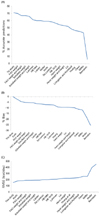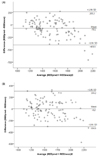1. Yatsuya H, Li Y, Hilawe EH, Ota A, Wang C, Chiang C, Zhang Y, Uemura M, Osako A, Ozaki Y, Aoyama A. Global trend in overweight and obesity and its association with cardiovascular disease incidence. Circ J. 2014; 78:2807–2818.

2. Pérez Rodrigo C. Current mapping of obesity. Nutr Hosp. 2013; 28:Suppl 5. 21–31.
3. Nahikian-Nelms M, Sucher KP, Lacey K, Roth SL. Nutrition Therapy and Pathophysiology. 2nd ed. Belmont (CA): Wadsworth, Cengage Learning;2011. p. 240.
4. Ndahimana D, Kim EK. Measurement methods for physical activity and energy expenditure: a review. Clin Nutr Res. 2017; 6:68–80.

5. Weijs PJ. Validity of predictive equations for resting energy expenditure in US and Dutch overweight and obese class I and II adults aged 18-65 y. Am J Clin Nutr. 2008; 88:959–970.

6. Siervo M, Bertoli S, Battezzati A, Wells JC, Lara J, Ferraris C, Tagliabue A. Accuracy of predictive equations for the measurement of resting energy expenditure in older subjects. Clin Nutr. 2014; 33:613–619.

7. Wouters-Adriaens MP, Westerterp KR. Low resting energy expenditure in Asians can be attributed to body composition. Obesity (Silver Spring). 2008; 16:2212–2216.

8. Wulan SN, Westerterp KR, Plasqui G. Ethnic differences in body composition and the associated metabolic profile: a comparative study between Asians and Caucasians. Maturitas. 2010; 65:315–319.

9. Bernstein RS, Thornton JC, Yang MU, Wang J, Redmond AM, Pierson RN Jr, Pi-Sunyer FX, Van Itallie TB. Prediction of the resting metabolic rate in obese patients. Am J Clin Nutr. 1983; 37:595–602.

10. de Lorenzo A, Tagliabue A, Andreoli A, Testolin G, Comelli M, Deurenberg P. Measured and predicted resting metabolic rate in Italian males and females, aged 18-59 y. Eur J Clin Nutr. 2001; 55:208–214.

11. Harris JA, Benedict FG. A biometric study of human basal metabolism. Proc Natl Acad Sci U S A. 1918; 4:370–373.

12. Roza AM, Shizgal HM. The Harris Benedict equation reevaluated: resting energy requirements and the body cell mass. Am J Clin Nutr. 1984; 40:168–182.

13. Mifflin MD, St Jeor ST, Hill LA, Scott BJ, Daugherty SA, Koh YO. A new predictive equation for resting energy expenditure in healthy individuals. Am J Clin Nutr. 1990; 51:241–247.

14. Müller MJ, Bosy-Westphal A, Klaus S, Kreymann G, Lührmann PM, Neuhäuser-Berthold M, Noack R, Pirke KM, Platte P, Selberg O, Steiniger J. World Health Organization equations have shortcomings for predicting resting energy expenditure in persons from a modern, affluent population: generation of a new reference standard from a retrospective analysis of a German database of resting energy expenditure. Am J Clin Nutr. 2004; 80:1379–1390.

15. Owen OE, Kavle E, Owen RS, Polansky M, Caprio S, Mozzoli MA, Kendrick ZV, Bushman MC, Boden G. A reappraisal of caloric requirements in healthy women. Am J Clin Nutr. 1986; 44:1–19.

16. Owen OE, Holup JL, D'Alessio DA, Craig ES, Polansky M, Smalley KJ, Kavle EC, Bushman MC, Owen LR, Mozzoli MA. A reappraisal of the caloric requirements of men. Am J Clin Nutr. 1987; 46:875–885.

17. Livingston EH, Kohlstadt I. Simplified resting metabolic rate-predicting formulas for normal-sized and obese individuals. Obes Res. 2005; 13:1255–1262.

18. Korth O, Bosy-Westphal A, Zschoche P, Glüer CC, Heller M, Müller MJ. Influence of methods used in body composition analysis on the prediction of resting energy expenditure. Eur J Clin Nutr. 2007; 61:582–589.

19. Huang KC, Kormas N, Steinbeck K, Loughnan G, Caterson ID. Resting metabolic rate in severely obese diabetic and nondiabetic subjects. Obes Res. 2004; 12:840–845.

20. Lazzer S, Agosti F, Silvestri P, Derumeaux-Burel H, Sartorio A. Prediction of resting energy expenditure in severely obese Italian women. J Endocrinol Invest. 2007; 30:20–27.

21. Lazzer S, Agosti F, Resnik M, Marazzi N, Mornati D, Sartorio A. Prediction of resting energy expenditure in severely obese Italian males. J Endocrinol Invest. 2007; 30:754–761.

22. Liu HY, Lu YF, Chen WJ. Predictive equations for basal metabolic rate in Chinese adults: a cross-validation study. J Am Diet Assoc. 1995; 95:1403–1408.
23. Luhrmann PM, Edelmann-Schafer B, Neuhauser-Berthold M. Changes in resting metabolic rate in an elderly German population: cross-sectional and longitudinal data. J Nutr Health Aging. 2010; 14:232–236.

24. Food and Agriculture Organization of the United Nations. World Health Organization. United Nations University. Energy and Protein Requirements: Report of a Joint FAO/WHO/UNU Expert Consultation. Geneva: World Health Organization;1985.
25. Henry CJ. Basal metabolic rate studies in humans: measurement and development of new equations. Public Health Nutr. 2005; 8:1133–1152.

26. Schofield WN. Predicting basal metabolic rate, new standards and review of previous work. Hum Nutr Clin Nutr. 1985; 39:Suppl 1. 5–41.
27. Weir JB. New methods for calculating metabolic rate with special reference to protein metabolism. J Physiol. 1949; 109:1–9.

28. de la Torre CL, Ramírez-Marrero FA, Martínez LR, Nevárez C. Predicting resting energy expenditure in healthy Puerto Rican adults. J Am Diet Assoc. 2010; 110:1523–1526.

29. Kim EK, Kim JH, Kim MH, Ndahimana D, Yean SE, Yoon JS, Kim JH, Park J, Ishikawa-Takata K. Validation of dietary reference intake equations for estimating energy requirements in Korean adults by using the doubly labeled water method. Nutr Res Pract. 2017; 11:300–306.

30. Rolfes SR, Pinna K, Whitney EN. Understanding Normal and Clinical Nutrition. 9th ed. Belmont (CA): Wadsworth, Cengage Learning;2012. p. 246–247.
31. Son HR, Yeon SE, Choi JS, Kim EK. The measurements of the resting metabolic rate (RMR) and the accuracy of RMR predictive equations for Korean farmers. Korean J Community Nutr. 2014; 19:568–580.

32. Lee SH, Kim EK. Accuracy of predictive equations for resting metabolic rates and daily energy expenditures of police officials doing shift work by type of work. Clin Nutr Res. 2012; 1:66–77.

33. Westerterp KR. Control of energy expenditure in humans. Eur J Clin Nutr. 2017; 71:340–344.

34. Ling CH, de Craen AJ, Slagboom PE, Gunn DA, Stokkel MP, Westendorp RG, Maier AB. Accuracy of direct segmental multifrequency bioimpedance analysis in the assessment of total body and segmental body composition in middle-aged adult population. Clin Nutr. 2011; 30:610–615.

35. Gibson AL, Holmes JC, Desautels RL, Edmonds LB, Nuudi L. Ability of new octapolar bioimpedance spectroscopy analyzers to predict 4-component-model percentage body fat in Hispanic, black, and white adults. Am J Clin Nutr. 2008; 87:332–338.

36. Jackson AS, Pollock ML. Generalized equations for predicting body density of men. Br J Nutr. 1978; 40:497–504.

37. Jackson AS, Pollock ML, Ward A. Generalized equations for predicting body density of women. Med Sci Sports Exerc. 1980; 12:175–182.

38. Jackson AS, Ellis KJ, McFarlin BK, Sailors MH, Bray MS. Cross-validation of generalised body composition equations with diverse young men and women: the Training Intervention and Genetics of Exercise Response (TIGER) Study. Br J Nutr. 2009; 101:871–878.

39. Hofsteenge GH, Chinapaw MJ, Weijs PJ. Fat-free mass prediction equations for bioelectric impedance analysis compared to dual energy X-ray absorptiometry in obese adolescents: a validation study. BMC Pediatr. 2015; 15:158.

40. Marra M, Montagnese C, Sammarco R, Amato V, Della Valle E, Franzese A, Contaldo F, Pasanisi F. Accuracy of predictive equations for estimating resting energy expenditure in obese adolescents. J Pediatr. 2015; 166:1390–1396.e1.

41. Lee GH, Kim MH, Kim EK. Accuracy of predictive equations for resting metabolic rate in Korean college students. Korean J Community Nutr. 2009; 14:462–473.
42. Cunningham JJ. A reanalysis of the factors influencing basal metabolic rate in normal adults. Am J Clin Nutr. 1980; 33(11):2372–2374.

43. Ganpule AA, Tanaka S, Ishikawa-Takata K, Tabata I. Interindividual variability in sleeping metabolic rate in Japanese subjects. Eur J Clin Nutr. 2007; 61:1256–1261.

44. Frisard MI, Broussard A, Davies SS, Roberts LJ 2nd, Rood J, de Jonge L, Fang X, Jazwinski SM, Deutsch WA, Ravussin E. Aging, resting metabolic rate, and oxidative damage: results from the Louisiana Healthy Aging Study. J Gerontol A Biol Sci Med Sci. 2007; 62:752–759.








 PDF
PDF ePub
ePub Citation
Citation Print
Print






 XML Download
XML Download